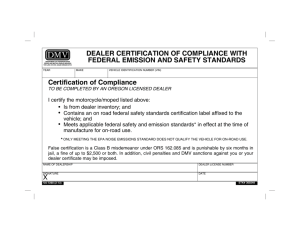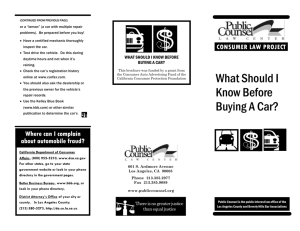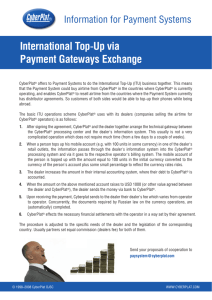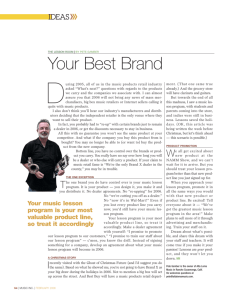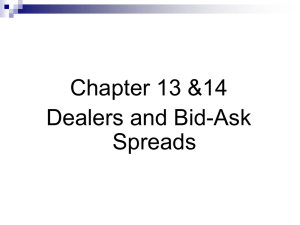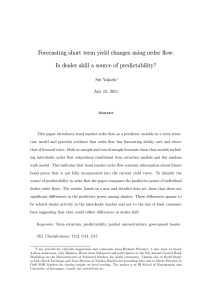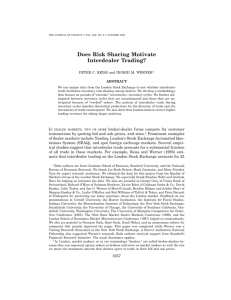Dealer Markets
advertisement
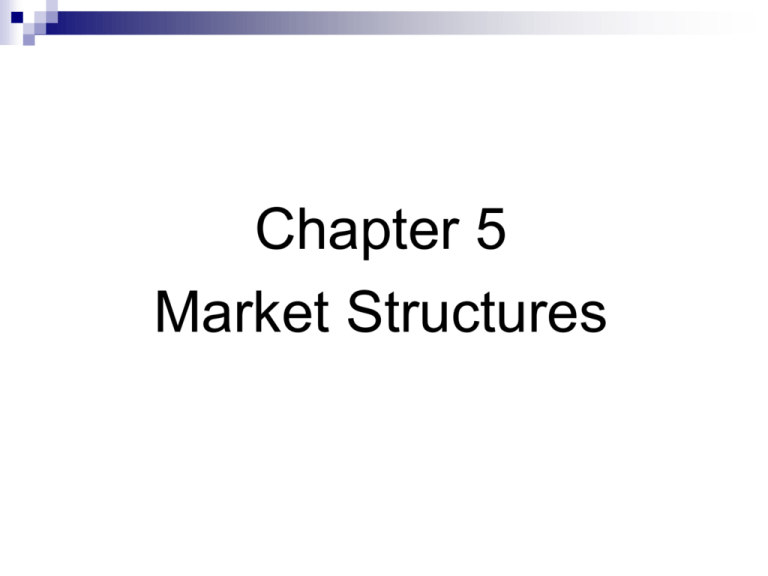
Chapter 5 Market Structures Trading sessions Trades take place during trading sessions. • • Continuous market sessions Call market sessions Continuous markets Traders may trade at anytime while the market is open. Traders may continuously attempt to arranger their trades. Dealer markets or quote driven markets are, by definition, continuous markets. Pros and cons of continuous markets Pros for continuous markets • Traders can arrange their trades whenever they want. • Information may be incorporated very fast into prices. Cons for continuous markets • more volatile Call markets Traders may trade in call markets only when the market is called. You may have all securities called at the same time or only some. The market may be called several times per day. Used to open sessions in continuous markets (Bourse de Paris, NYSE,…). Also used for less active securities, bonds,…. Pros and cons of call markets Pros for call markets • Focus the attention of traders on the same security at the same time. • Less volatility Cons for call markets • Information may need a lot of time to be incorporated into prices. Execution systems The execution system matches the buyers with the sellers. quote-driven markets order-driven markets brokered markets hybrid markets Quote-driven dealer markets In pure quote-driven markets, dealers participate in every trade. Dealers provide all the liquidity and quote bid and ask prices. Those quotes are firm for some specified size, i.e., the dealers must honor them. If the investor wants to trade a different size, there will be negotiation between the investor and the dealer. Buy orders decrease the dealer’s inventory position whereas sell orders increase the dealer’s inventory position. The dealer can then attract or reject order flow given her inventory position. The bidask spread’s placement will then reflect her inventory position. When the dealer’s inventory position is low, she sets both a high bid price and a high ask price. When the dealer’s inventory position is high, she sets both a low bid and a low ask. Examples of Dealer Markets: • • • • NASDAQ London International Stock Exchange (SEAQ) OTC Bond Markets Foreign Exchange Markets General features of a dealer market Multiple dealers, geographically dispersed, electronically linked. No consolidation of trading: No “floor”. Virtually all customer trades are with a dealer. The dealer is the intermediary. Customers rarely trade against other customers. Dealers trade among themselves. Regulation and transparency are poor relative to floor markets. Dealers may compete among themselves, but have a lot of information and market power relative to customers. Dealer market: NASDAQ/SEAQ Two or more market makers per stock Trades were mainly phone negotiated Roughly 95% of the volume went through MM book No central limit order book. Small order execution automated, but not larger orders. Complete decentralization Dealer obligations Provide quotes during trading hours Offer “best execution” Report trades in a timely manner Fair communication Order-driven markets (Ch. 6) In an order-driven auction market, all traders issue orders to the exchange. Buyers and sellers regularly trade with each other without the intermediation of dealers. But dealers may choose to trade. Order driven markets may be organized as continuous markets or as call markets. Brokered markets Brokers match up buyer and seller. • Search is often required to match buyer and sellers for less liquid items, and for large blocks of securities • Brokers specialize in locating counterparts to difficult orders • Concealed traders • Latent traders Examples of brokered markets include: • Block trading (stocks and bonds) • Real estate • Business concerns Hybrid markets Hybrid markets mix aspects of the various structures. The most common hybrid markets are those with dealer-specialists. These markets are order-driven auction markets in which the specialist must provide liquidity under some circumstances. Most US stock exchanges and options exchanges have specialist systems. Market information systems It is of utmost important that orders are not lost and that order instructions are understood. • Ticker symbols • Order routing systems • Order presentation systems Screen-based trading systems – electronic Messaging systems – private messages The information created by trading is valuable. Market data systems report trades and quotes to the public Markets sell information to data vendors Data vendors offer broadcast and query services • Broadcast services - Continuous Query services – on demand Transparency is a key feature of markets. • Ex ante vs. ex post transparency • Price and sale feeds Ticker tapes Quotation feeds
